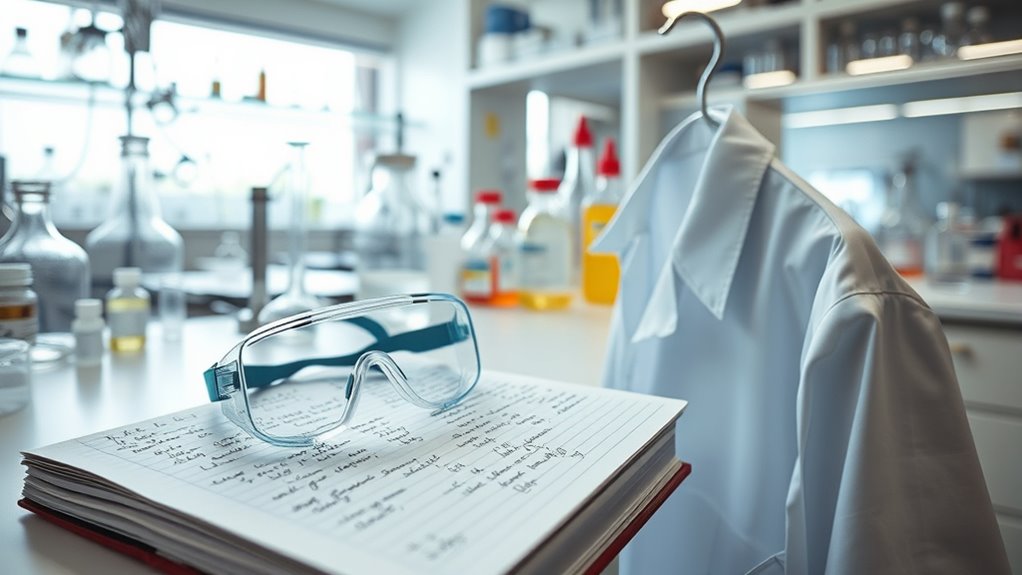Building a strong lab safety culture means creating daily habits that protect you and your colleagues. Prioritize regular equipment checks, report issues promptly, and participate in emergency drills. When safety becomes second nature, it reduces risks and prevents accidents before they happen. Leadership plays a key role in reinforcing safe practices and promoting shared responsibility. Staying committed to these routines guarantees a safer lab environment—continue exploring ways to embed safety into every aspect of your work.
Key Takeaways
- Foster a safety-first mindset through routine equipment checks and prompt issue reporting to embed safety into daily lab practices.
- Regularly conduct safety drills and emergency response training to build confidence and preparedness among lab personnel.
- Ensure consistent leadership support and role modeling to reinforce safety expectations and shared responsibility.
- Prioritize equipment maintenance and inspections to prevent malfunctions and reduce accident risks.
- Cultivate a culture where safety is ingrained as an automatic habit, reducing reliance on rules alone and promoting responsible behavior.

Have you ever wondered why some labs prioritize safety while others overlook it? The answer often lies in their safety culture—the ingrained habits and attitudes that shape everyday practices. When safety becomes a core value, it influences everything from equipment maintenance to emergency preparedness, creating an environment where risks are minimized, and lives are protected. On the other hand, neglecting these aspects can lead to dangerous situations, injuries, or even fatalities. Building a strong safety culture isn’t accidental; it requires deliberate effort and consistency.
A strong safety culture transforms habits, minimizing risks and protecting lives through deliberate, consistent practices.
One of the key components is equipment maintenance. When you keep lab equipment in excellent condition, you reduce the risk of malfunctions that could cause accidents. Regular inspections, calibration, and timely repairs aren’t just routine tasks—they’re essential safety measures. Proper maintenance ensures that devices work as intended, preventing leaks, explosions, or exposure to hazardous materials. Investing in preventative maintenance is crucial for maintaining a safe laboratory environment.
When everyone understands that equipment upkeep isn’t optional but indispensable for safety, it fosters a proactive mindset. This habit not only protects you but also your colleagues and the integrity of your research.
Emergency preparedness is equally indispensable. A lab that’s ready for unexpected incidents cultivates confidence and swift responses. You should know the location of safety showers, fire extinguishers, and first aid kits. Regular drills reinforce this knowledge, ensuring that in a real emergency, panic is minimized, and actions are effective.
Emergencies can happen suddenly—chemical spills, fires, electrical failures—and the difference between chaos and control often hinges on how prepared you are. When emergency protocols are well-practiced and understood by everyone, it becomes second nature to act quickly and correctly, saving lives and preventing damage.
Creating a safety-first mindset involves more than just following rules; it’s about cultivating habits that become second nature. When you routinely check equipment before use, report any issues promptly, and participate actively in emergency drills, safety becomes part of your daily routine.
Leadership plays a key role here, setting expectations and modeling responsible behavior. Recognizing and reinforcing safe practices encourages everyone to take ownership of safety, making it a shared priority rather than just an obligation.
In essence, fostering a robust lab safety culture means making safety habits automatic, not an afterthought. Proper equipment maintenance and comprehensive emergency preparedness aren’t just policies—they’re the foundation of a safe, productive environment.
When these practices become ingrained routines, you help build a workplace where accidents are rare, careers are protected, and lives are saved. It’s about creating an atmosphere where safety is woven into every action, ensuring that everyone goes home safe at the end of each day.
Frequently Asked Questions
How Do I Handle Safety Violations Without Fear of Retaliation?
You handle safety violations confidently by fostering peer accountability and encouraging a culture where colleagues feel responsible for each other’s safety. Use anonymous reporting options to voice concerns without fear of retaliation.
When you see a violation, address it calmly and constructively, or report it through established channels. Remember, prioritizing safety benefits everyone, and creating a supportive environment helps guarantee issues are addressed promptly and without fear.
What Role Does Leadership Play in Fostering Safety Culture?
Leadership plays a vital role in fostering safety culture by demonstrating commitment and prioritizing safety. Your leaders should actively engage in safety communication, openly discussing safety concerns and encouraging team feedback.
When leaders show they value safety, it builds trust and motivates everyone to follow safety protocols. Your organization thrives when leadership sets the example, reinforces safety standards, and creates an environment where safety is everyone’s shared responsibility.
How Can New Employees Quickly Adapt to Safety Protocols?
You might think new employees need extensive training to adopt safety protocols, but quick adaptation is possible with mentoring programs and peer feedback.
By pairing newcomers with experienced team members, you accelerate learning and build confidence. Encouraging open communication allows new hires to ask questions and clarify procedures, making safety habits stick faster.
This proactive approach creates a strong safety culture from day one, protecting everyone and fostering lasting responsibility.
What Are Effective Ways to Reinforce Safety Habits Regularly?
You can effectively reinforce safety habits by implementing regular behavior reinforcement and habit tracking. Schedule frequent safety check-ins and encourage team members to share safety successes.
Use visual cues and reminders around the lab to keep safety top of mind. Tracking progress helps identify areas for improvement, motivating everyone to stay committed.
Consistent reinforcement builds safe habits, making safety a natural part of your daily routine.
How Do Safety Cultures Differ Across Various Laboratory Disciplines?
You’ll find that safety cultures vary widely across lab disciplines—for example, chemistry labs emphasize chemical handling, while biology labs focus on biohazard precautions.
Interdisciplinary collaboration often fosters shared safety standards, but tailored safety training programs are essential for discipline-specific risks.
About 70% of labs report better safety adherence when they adapt practices to their unique environment, highlighting the need for customized approaches to build effective safety cultures across diverse fields.
Conclusion
Remember, cultivating a strong safety culture can make all the difference—your habits protect not just your career, but your life. Did you know that labs with rigorous safety protocols see a 50% reduction in accidents? That’s a powerful reminder that your daily choices matter. By building safe habits, you create a safer environment for everyone around you. Stay vigilant, stay safe, and never underestimate the impact of your commitment to lab safety.









